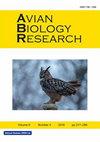Phylogenetic relationships and genetic variations among cinereous vultures Aegypius monachus in South Korea
IF 1.2
4区 农林科学
Q4 AGRICULTURE, DAIRY & ANIMAL SCIENCE
引用次数: 1
Abstract
Mature individuals of the cinereous vulture, Aegypius monachus, number 15,600–21,000 birds worldwide and population size of the bird has been in decline due to poisoned baits and the decreasing availability of food. Approximately 12–16% of the global population of cinereous vultures spend their winters in Korean regions that are hence important areas. In this study, the population structure and genetic diversity of the cinereous vulture in South Korea were evaluated to clarify the relationships between the Mongolian and South Korean populations with genetic diversity assessed using mitochondrial DNA (mtDNA) and microsatellite markers. In the South Korean population, two unique haplotypes (Hap8 and Hap9) were newly discovered in their mtDNA, with three polymorphic sites and low-level genetic diversity. Most of the cinereous vultures in South Korea were represented by a single haplotype, Hap8, and analyses of phylogenetic trees and the haplotype network illustrated that Hap8 was clustered in Lineage D (Mongolia). Notably, the other haplotype, Hap9, was only identified in one individual in South Korea with an unexpected clustering in Lineage C (Caucasus region, Armenia, Georgia, and Kazakhstan populations), which indicated that it might have been a vagrant bird. The microsatellite loci (n = 21) isolated from South Korean cinereous vultures indicated comparatively lower genetic variation, with a K value of 1. These results indicate that the origin of the South Korean population is most likely from one source population of the Far Eastern cluster (Mongolian population), which was also supported by the outcome of mtDNA analysis. This study improves our understanding of the population structure and genetic diversity between the Mongolian and South Korean cinereous vulture populations.韩国灰蝶秃鹫的系统发育关系和遗传变异
灰兀鹫(Aegypius monachus)的成熟个体在全球范围内有15600–21000只,由于毒饵和食物供应减少,该鸟的种群规模一直在下降。全球约有12-16%的灰兀鹫在韩国地区过冬,因此这些地区是重要的地区。在本研究中,评估了韩国灰兀鹫的种群结构和遗传多样性,以阐明蒙古和韩国种群之间的关系,并使用线粒体DNA(mtDNA)和微卫星标记评估了遗传多样性。在韩国人群中,mtDNA中新发现了两种独特的单倍型(Hap8和Hap9),具有三个多态位点和低水平的遗传多样性。韩国的大多数灰蝶秃鹫都由一个单倍型Hap8代表,系统发育树和单倍型网络的分析表明,Hap8聚集在D系(蒙古)。值得注意的是,另一个单倍型Hap9仅在韩国的一个个体中被发现,在C系(高加索地区、亚美尼亚、格鲁吉亚和哈萨克斯坦种群)中出现了意外的聚集,这表明它可能是一只流浪鸟。从韩国灰兀鹫中分离出的微卫星基因座(n=21)显示出相对较低的遗传变异,K值为1。这些结果表明,韩国人口的起源很可能来自远东集群的一个来源人口(蒙古人口),mtDNA分析的结果也支持了这一点。这项研究提高了我们对蒙古和韩国灰兀鹫种群结构和遗传多样性的理解。
本文章由计算机程序翻译,如有差异,请以英文原文为准。
求助全文
约1分钟内获得全文
求助全文
来源期刊

Avian Biology Research
农林科学-奶制品与动物科学
CiteScore
1.50
自引率
0.00%
发文量
17
审稿时长
2 months
期刊介绍:
Avian Biology Research provides a forum for the publication of research in every field of ornithology. It covers all aspects of pure and applied ornithology for wild or captive species as well as research that does not readily fit within the publication objectives of other ornithological journals. By considering a wide range of research fields for publication, Avian Biology Research provides a forum for people working in every field of ornithology.
 求助内容:
求助内容: 应助结果提醒方式:
应助结果提醒方式:


